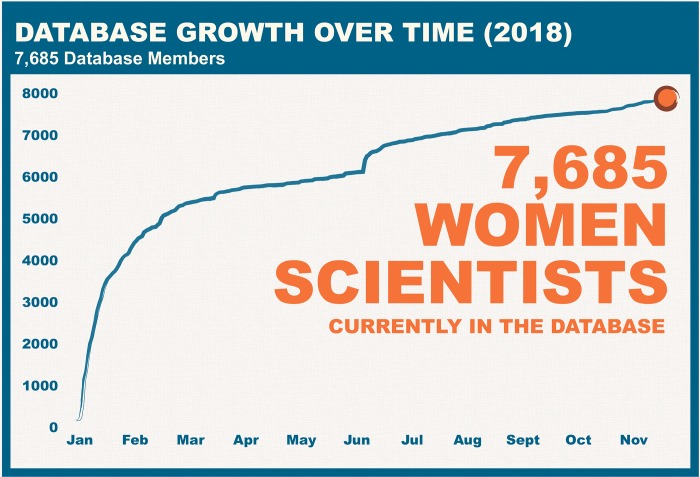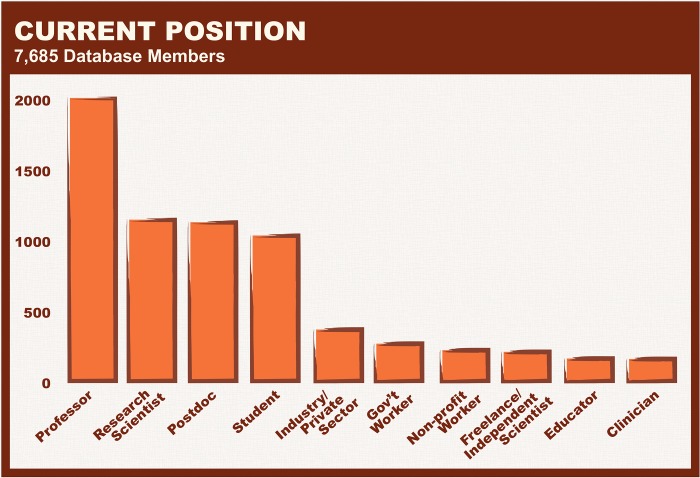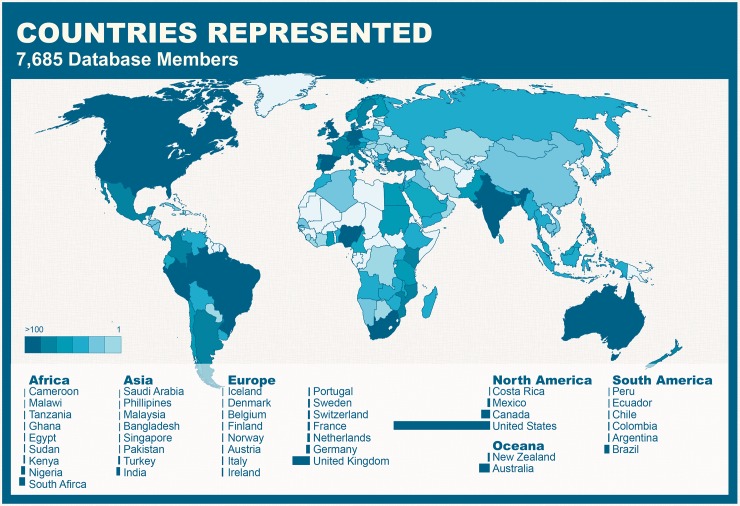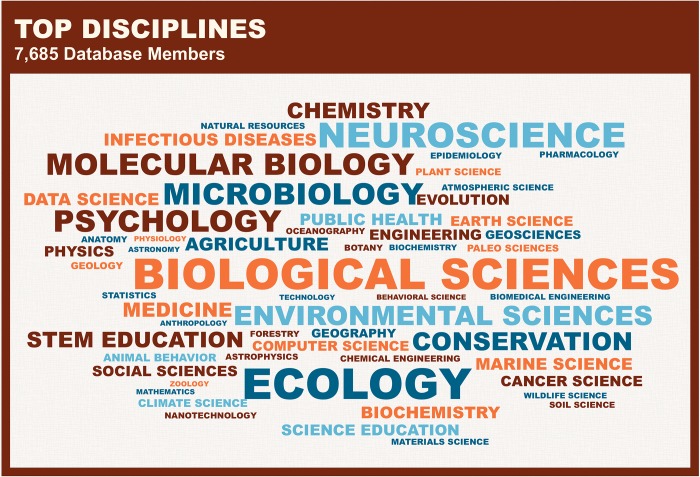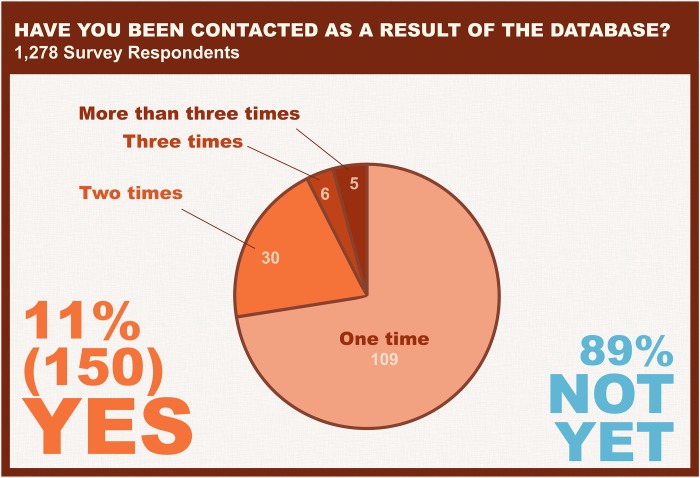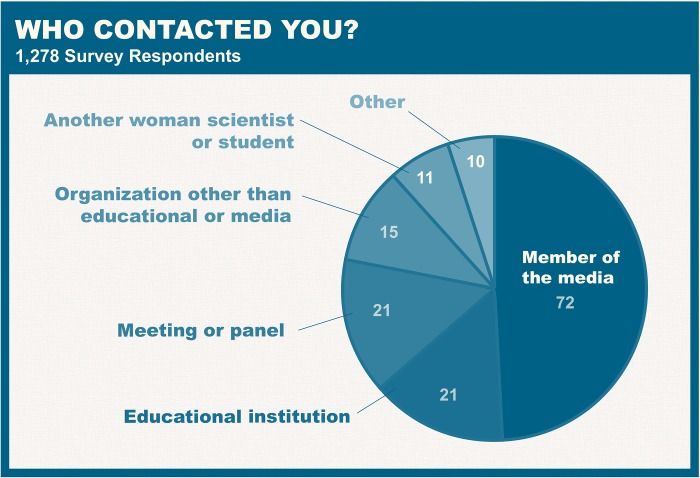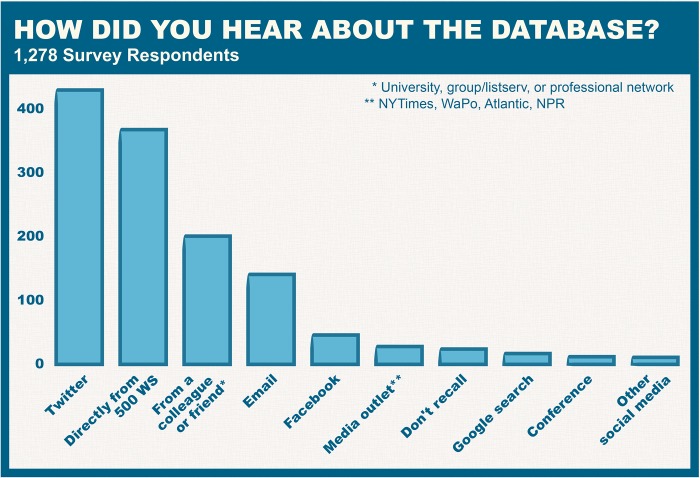Abstract
A global online register of women scientists, ready to share their science, was established by a cohort of volunteer women from the grassroots organization 500 Women Scientists on January 17th, 2018. In less than one year, the database “Request a Woman Scientist” comprised over 7,500 women from 174 scientific disciplines and 133 countries. The database is built upon a voluntary questionnaire regarding career stage, degree, scientific discipline, geographic location, and other self-identifying dimensions of representation. The information was visualized using the software platform Tableau, with dropdown menus that help query the database and output a list of names, email addresses, and websites. The biological sciences and women scientists from the United States of America were best represented in the database. A survey of women in the database conducted in November 2018 showed that of 1,278 respondents, 11% had been contacted since signing up for a variety of engagements, including media, peer review, panel participation, educational outreach, and professional/research connections. These engagements resulted in consultations for articles, video chats with students, and speaking opportunities at conferences and events. With improved functionality and marketing, outreach in the global south, and future translation in other languages, this database will further promote the profile and participation of women scientists across society, which in turn will benefit the advancement of science.
This Community Page article describes the “Request a Woman Scientist” resource, which was launched in January 2018 through the 500 Women Scientists organization, and constitutes an important step in increasing the diversity of voices represented as scientists in the public and scientific communities.
Request a Woman Scientist
On January 17th, 2018, 500 Women Scientists (Box 1) launched the Request a Woman Scientist platform (https://500womenscientists.org/request-a-scientist/) to provide an easy to use tool to increase representation of women scientists in the scientific community and public sphere. The idea came from repeated experiences of seeing all men panels (“manels”) and women’s scientific expertise often excluded in the public realm. A 2017 study analyzing colloquium speakers at 50 prestigious universities found that men were invited to give twice as many talks about their research as women [1]. Conference and symposium organizers repeatedly use the same excuses for this imbalance—from “We tried to find a woman to speak on this panel, but we didn’t know any women who work on this topic” to “All the women we asked said no or were unavailable.” The gender gap in scientific forums trickles down into representations of scientists in the media. Women experts are less likely to be cited as sources in news articles about scientific developments, even though they are more engaged in science outreach and communication compared to their male colleagues [2,3]. The underrepresentation of women perpetuates a broader issue in science—expertise relayed to the public does not reflect the true diversity of people and perspectives in science today and across society at large. Furthermore, the lack of visibility of women experts reinforces the idea that science can only be accessed and informed by people who conform to the white male scientist stereotype. These stereotypes influence the next generation’s perceptions of who can practice science. For instance, in a 2018 study, only three in 10 US children drew a woman scientist when asked to draw a picture of what a scientists looks like [4]. That figure, however meager, is a marked improvement from when the surveys and the first study was conducted between in 1966, 1977, and 1983, respectively, when only 1% of children drew women scientists [5].
Box 1. 500 Women Scientists
500 Women Scientists is a grassroots organization with the mission to serve society by making science open, inclusive, and accessible. The organization works to transform leadership, diversity, and public engagement in science. Since its inception, 500 Women Scientists has amplified the voices of women scientists in the public sphere (https://goo.gl/kqrZPg). 500 Women Scientists provides resources (https://500womenscientists.org/resources/) to support the success of women in science and works to change perceptions of what a scientist looks like. 500 Women Scientists is organized through groups of women, called pods, who work to achieve the goals of the overall larger organization in their local communities. Currently, there are 292 pods around the world.
To confront the stereotypes of who can be a scientist and to facilitate contact with women scientists, the Request a Woman Scientist platform serves to connect educational institutions, policy makers, members of the public, media, and others with women scientists across scientific disciplines and geographical regions. These women have indicated their willingness to speak with students or the media, consult on a project, sit on a panel, or serve as a conference keynote speaker. The platform helps people find women with the relevant expertise and experience and, at the same time, highlight other areas for inclusion to deepen representation across dimensions of diversity.
Who is participating in Request a Woman Scientist?
As with the 500 Women Scientists open letter (https://500womenscientists.org/our-pledge/) that reached thousands of women across the world, the Request a Woman Scientist platform spread rapidly (sign up here: https://goo.gl/3NJ8hk). Since its launch in January 2018 (Fig 1; all figures were generated in November 2018, and raw data tables are available in S1 Data), over 7,500 women from 133 countries signed up to be a resource, and the platform has been accessed more than 100,000 times by journalists, conference organizers, school teachers, and other scientists.
Fig 1. Database growth over time.
The number of women who have signed up for the database has grown rapidly in the time since its launch.
Self-identified women scientists fill out the Google form and members of 500 Women Scientists vet each entry. This vetting includes checking that the person signing up is indeed a self-identified woman from a science, technology, engineering, math, and medicine (STEMM) field and that the linked information is accurate. The vetting process ensures that the database is accurate and up to date. The searchable graphical user database (gui) was designed in Tableau (Seattle, Washington) as an interactive map with circles of proportional size representing women in that area. The women in the resource are searchable by discipline (which is a set predefined field) as well as by location, participation interest(s) (e.g., keynote address, expert quote, outreach), whether they self-identify as an underrepresented minority, and additional self-defined keywords. The output consists of a list of the names of women scientists, their contact information (most often email address), and their website(s) when provided—the query is exportable as pdf, csv, or weblink.
Recruitment for the platform has primarily been through social media, with no additional marketing. The resource is composed primarily of faculty members, followed by a roughly equal representation of students, postdocs, and research scientists (Fig 2). Although the platform was launched in the US and approximately half of participants work in the US, the database has had larger than expected international participation, with women scientists from 133 countries represented and highest participation from women scientists in a single location: London, United Kingdom (Fig 3). There are many women participants from almost every continent in the world, with greatest participation in Australia (Melbourne), South Africa (Cape Town), UK (London), India (Bangalore), Brazil (São Paulo), and the US (Washington, DC).
Fig 2. Current position.
The number of women represented in each position are shown, with the majority of women in the database identifying as professors.
Fig 3. Countries represented.
The countries represented in the database are shown in blue, with darker blue indicating greater representation.
Of women who responded, 22.7% (4,338 in total) identify as an underrepresented minority. The majority of women selected biological sciences as their primary discipline (up to three disciplines can be selected) (Fig 4, showing only the primary indicated discipline), which is consistent with data that women are well represented in the biological sciences [6].
Fig 4. Top disciplines.
The top disciplines represented in the database are shown, with size indicating greater representation in that discipline.
Who is using the Request a Woman Scientist database?
The database was designed to allow users to easily locate women by a number of parameters, including location, field of expertise, degree status, whether they belong to an underrepresented minority group, and through additional custom keywords. The database could be used for multiple purposes. For instance, an organizer for a seminar on climate change could query the resource to find local women climate scientists to invite as speakers. A journalist seeking to find an expert on genetic techniques could query the keyword “CRISPR” (a new method for gene editing) or “gene editing,” while filtering for women interested in speaking to a journalist, to contact their next source. An early career trainee interested in exploring nonacademic careers could use the database to find a woman pursuing a career in policy to contact for an informational interview.
Several journalists have used the database exclusively to source their stories, including for pieces in The Atlantic (https://www.theatlantic.com/science/archive/2018/02/i-spent-two-years-trying-to-fix-the-gender-imbalance-in-my-stories/552404/), Grist (https://grist.org/article/women-scientists-were-not-backing-down-and-were-not-going-away), and online National Geographic (https://news.nationalgeographic.com/2018/02/wildlife-watch-lab-monkey-testing-volkswagen-auto-industry/).
Who has been contacted through the Request a Woman Scientist database?
With a range of possible applications, 500 Women Scientists sought to better understand how the database was being used in practice. In November 2018, a voluntary survey was distributed to all women in the database. Of the 7,500 women surveyed, 1,278 responded (16%). One of the goals of the survey was to assess whether women were being contacted through the resource and by whom. Of those who responded to the survey, 11% (150 individuals) had been contacted through the resource, with the majority contacted only once (Fig 5). This figure may be an underestimate of the true number of women contacted through the resource, as users of the database may not have specified that they found a given expert through the resource. As can be seen in Fig 6, members of the media represent the majority of users of the resource, followed by conference organizers and educational institutions. Lastly, in order to improve future marketing and recruitment of women, women were asked how they heard about the resource, and top responses included Twitter, 500 Women Scientists, colleagues, Facebook, and media coverage (Fig 7).
Fig 5. Have you been contacted as a result of the database?
Of those who responded to the survey, 11% have been contacted, with the majority of survey respondents having been contacted once.
Fig 6. Who contacted you?
The majority of those who responded to the survey and had been contacted through the “Request a Woman Scientist” resource were contacted by members of the media.
Fig 7. How did you hear about the database?
The majority of those who responded to the survey heard about the “Request a Woman Scientist” resource from Twitter.
Next directions
In 2019, the database will be revamped to improve its functionality and integrate additional disciplines, including the medical sciences. At the same time, the platform will include tracking features to assess how the site is being accessed and to measure impact. The goal of the Request a Woman Scientist platform is to increase representation of women scientists in society and change perceptions of what a scientist looks like. Therefore, building assessment functionality into the platform is critical to understand whether the resource is meeting its intended goals. In addition, the option to save queries for future use will be created by implementing user profiles, which will in turn enable tracking who is using the resource and for what purpose. 500 Women Scientists will also explore promotional strategies to increase enrollment of women from disciplines, industries, and geographical regions that are currently underrepresented in the database, including women in engineering and technology and women from the Global South. A possible approach would be targeting communities through societies like the Institute of Electrical and Electronics Engineers (IEEE), Women in Technology International (WITI), and Organization for Women in Science for the Developing World (OWSD) through strategic partnerships or outreach at conferences.
Other resources
The Request a Woman Scientist resource has inspired women in medicine to create a similar platform, with fields that are more specific to the medical sciences. 500 Women in Medicine has been created as a subgroup, recognizing that the medical communities have additional unique needs from those of the scientific research community. As a result, 500 Women Scientists is working to build an integrated database that can serve those needs as well as those of the broader STEMM disciplines. In addition, there are other resources that aim to increase participation of underrepresented groups in the sciences or to help scientists engage with the community, a selection of which are highlighted in Table 1.
Table 1. Resources related to 500 Women Scientists’ Request a Women Scientist.
| Resource name | Purpose | Geographical region | Discipline(s) | URL |
|---|---|---|---|---|
| Academic.net | Profile excellent female researchers | Europe | All | http://www.academia-net.org/ |
| American Physical Society Minority Speakers List | List names and contact information for underrepresented minorities in physics who are willing to speak on a variety of topics | North America | Physics | https://www.aps.org/programs/minorities/speakers/index.cfm |
| American Physical Society Women Speakers List | List name and contact information for women physicists who are willing to speak on a variety of topics | North America | Physics |
https://www.aps.org/programs/women/speakers/index.cfm |
| Anne’s List | Highlight female systems neuroscientists | Global | Neuroscience | https://anneslist.net/ |
| The Brussels Binder | Improve diversity in policy debates | Global | Policy | https://brusselsbinder.org/ |
| Climate Voices | Bring together citizens and scientists to discuss climate science and local climate change impacts | Global | Climate Science | https://climatevoices.org/ |
| Diversify EEB | Highlight ecologists and evolutionary biologists who are women and/or underrepresented minorities | Global | Ecology and Evolutionary Biology | https://diversifyeeb.wordpress.com/ (currently migrating to a new site) |
| Diverse Sources | Make it easy for people to find underrepresented experts in areas of science, health, and environment | Global | Science, Health, Environment | https://diversesources.org/ |
| Diversity Chemistry | Highlight the diverse community of academic chemists | Global | Chemistry | https://diversifychemistry.com/ |
| IWS network | Build a collaborative environment for immigrant and international women in science that nourishes inclusion and diversity in Canada | Canada | All | iwsnetwork.ca |
| SciLine | Provide timely access to trustworthy, articulate scientific experts for journalists and other communicators working in print, broadcast, or digital fields | Global | SciComm | https://www.sciline.org/ |
| Skype a Scientist | Match scientists with classrooms | Global | All | https://www.skypeascientist.com/ |
| TechWorld’s UK Women in Tech Speaker List | List of women in technology who can speak at tech events | UK | Technology | https://www.techworld.com/careers/here-are-571-uk-women-who-could-speak-at-your-tech-event-3645661/ |
| Women Also Know Stuff | Provide searchable database that promotes and publicizes work and expertise of political scientists | Global | Political Science | https://womenalsoknowstuff.com/ |
| Women in Agriculture | Provide list of women in agriculture | Global | Agriculture | https://docs.google.com/spreadsheets/d/1DbEnbdpjGz1VB28BRlJY9sKBpg0R5bDc7uRb9kfq-DE/edit#gid=0 |
| Women in Astronomy | Provide a database for women in astronomy | Global | Astronomy | https://cswa.aas.org/WIAD.html |
| Women in Machine Learning | Directory of women in machine learning | Global | Machine Learning | https://wimlworkshop.org/sh_projects/directory/ |
| Women’s Media Center | Raise visibility, viability, and decision-making power of women and girls in media | USA | Media | http://www.womensmediacenter.com/shesource |
| Women in Microbiology | List of women in fields of microbiology and related fields | Global | Microbiology | https://microbiomedigest.com/sample-page/women-in-microbiology-for-keynote-lectures/ |
| Women in Polar Science | Connect women in polar science | Global | Polar Science | https://twitter.com/womeninpolarsci?lang=en |
| Women in Soil Science | List of women in soil science and overlapping fields such as agronomy | Global | Soil Science | https://franciskadevries.wordpress.com/women-in-soil-science/ |
| Women in Radiology Informatics | Advance women in medical imaging informatics | Global | Radiology Informatics | http://radxx.ambrahealth.com/community/ |
| Women in Theoretical/Computational Chemistry, Material Science, and Biochemistry | Provide directory of women in theoretical/computational chemistry, material science, and biochemistry | Global | Theoretical/Computational Chemistry, Material Science, and Biochemistry | http://iopenshell.usc.edu/wtc/index.html |
Conclusions
There is a clear need for databases such as Request a Woman Scientist. This is evident from its use by members of the media, educational institutions, researchers, and others. The resource tackles the key excuse of panel organizers of “not being able to find women experts.” However, despite the success of the resource to attract enrollees from around the world in its first year, 500 Women Scientists is well aware that there are far more than 7,500 women in STEMM fields globally. With a revamp of the platform to improve functionality and dedicated marketing, the resource aims to include more women scientists from around the world and to offer an easy-to-use tool to boost visibility of women scientists.
Supporting information
Each tab indicates the data for each respective figure.
(XLSX)
Acknowledgments
We would like to acknowledge all of the members of 500 Women Scientists who have helped with the vetting process. In addition, we would like to thank all of the women who have signed up to be a resource and helped to spread the word. Lastly, we would like to thank Tableau for donating software as well as helping to troubleshoot and execute the gui.
Abbreviations
- gui
graphical user database
- IEEE
Institute of Electrical and Electronics Engineers
- OWSD
Organization for Women in Science for the Developing World
- STEMM
science, technology, engineering, math, and medicine
- WITI
Women in Technology International
Data Availability
All relevant data are within the paper and its Supporting Information files.
Funding Statement
KN was supported through a 2018 fellowship from The Safina Center (http://safinacenter.org/). EAM was supported through NIDCD 3T32DC012280-05S1. The funders had no role in study design, data collection and analysis, decision to publish, or preparation of the manuscript.
References
- 1.Nittrouer CL, Hebl MR, Ashburn-Nardo L, Trump-Steele RCE, Lane DM, Valian V. Gender disparities in colloquium speakers at top universities. Proc Natl Acad Sci USA. 2018. January 2;115(1):104–8. 10.1073/pnas.1708414115 [DOI] [PMC free article] [PubMed] [Google Scholar]
- 2.Ecklund EH, James SA, Lincoln AE. How Academic Biologists and Physicists View Science Outreach. PLoS ONE. 2012. April 30;7(5):e36240 10.1371/journal.pone.0036240 [DOI] [PMC free article] [PubMed] [Google Scholar]
- 3.Lafrance Adrienne. I Analyzed a Year of My Reporting for Gender Bias (Again). The Atlantic. 17 February 2016. Available from: https://www.theatlantic.com/technology/archive/2016/02/gender-diversity-journalism/463023/ Cited 25 Nov 2018. [Google Scholar]
- 4.Miller DI, Nolla KM, Eagly AH, Uttal DH. The Development of Children's Gender-Science Stereotypes: A Meta-analysis of 5 Decades of U.S. Draw-A-Scientist Studies. Child Dev. 2018. March 20;89(6):1943–55. 10.1111/cdev.13039 [DOI] [PubMed] [Google Scholar]
- 5.Chambers D. W. (1983), Stereotypic images of the scientist: The draw‐a‐scientist test. Sci. Ed., 67: 255–265. 10.1002/sce.3730670213 [DOI] [Google Scholar]
- 6.National Center for Education Statistics, “Table 318.30: Bachelor’s, Master’s, and Doctor’s Degrees Conferred by Postsecondary Institutions, By Sex of Student and Discipline Division: 2014–15,” Digest of Education Statistics: 2016 Tables and Figures (2017).
Associated Data
This section collects any data citations, data availability statements, or supplementary materials included in this article.
Supplementary Materials
Each tab indicates the data for each respective figure.
(XLSX)
Data Availability Statement
All relevant data are within the paper and its Supporting Information files.



